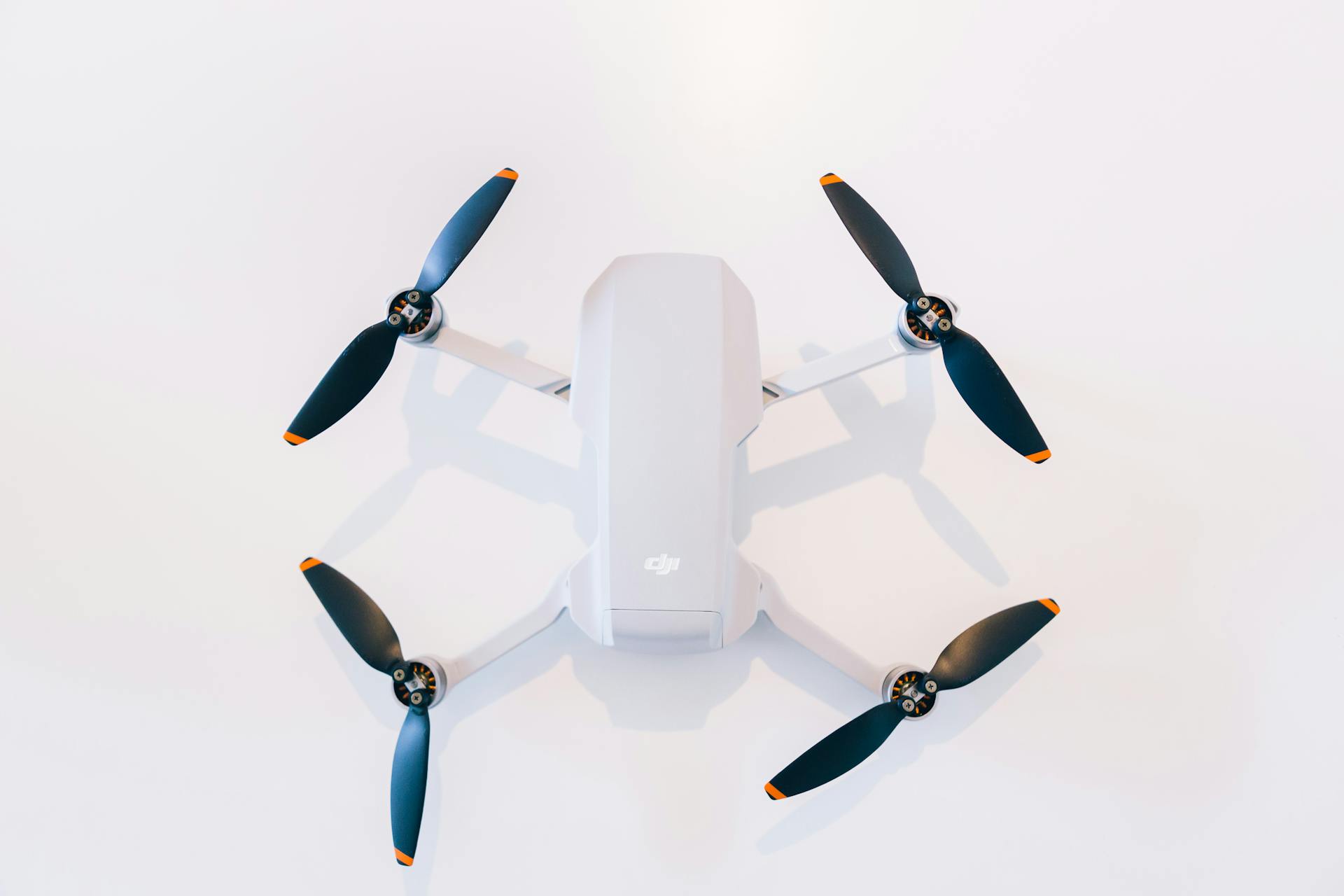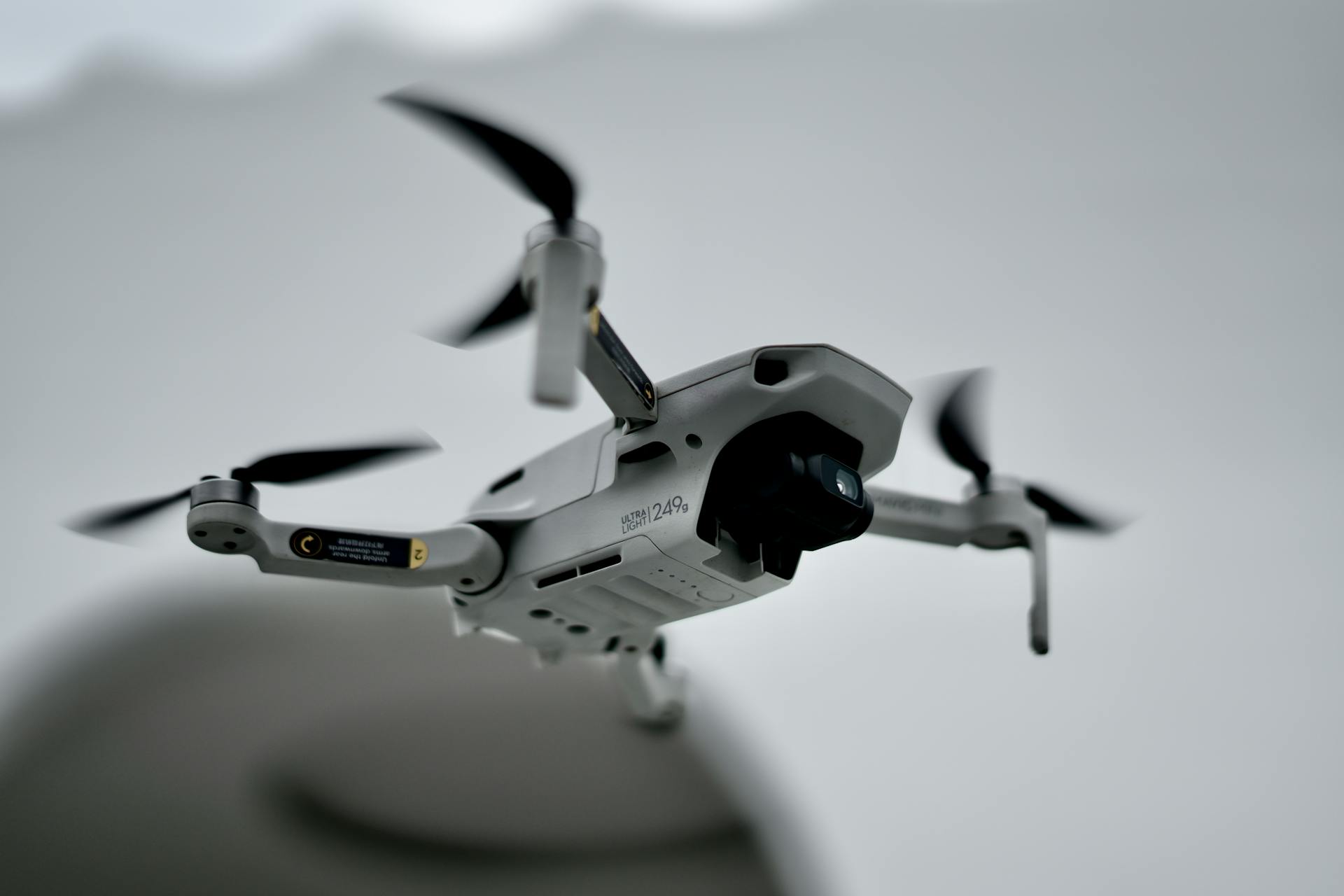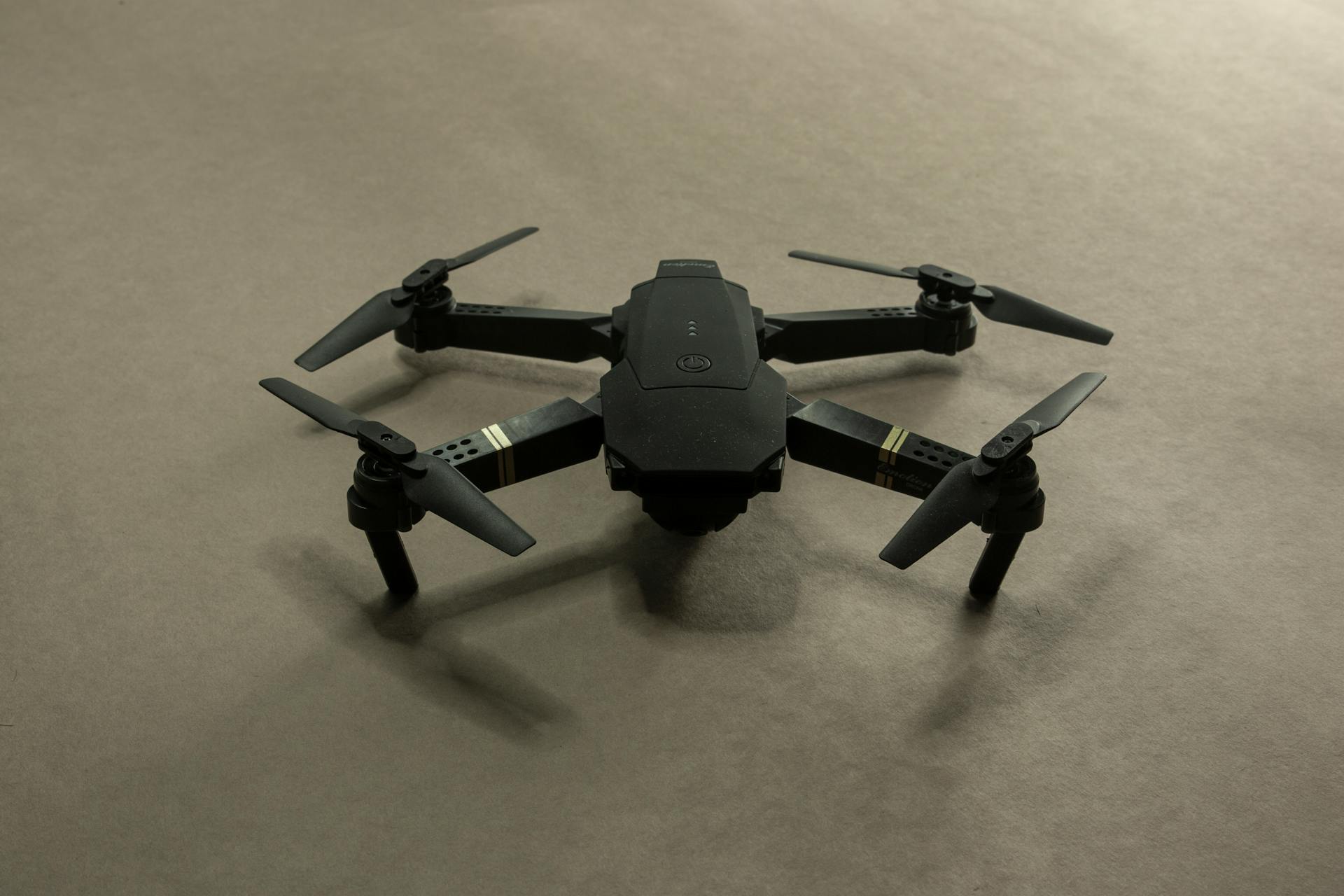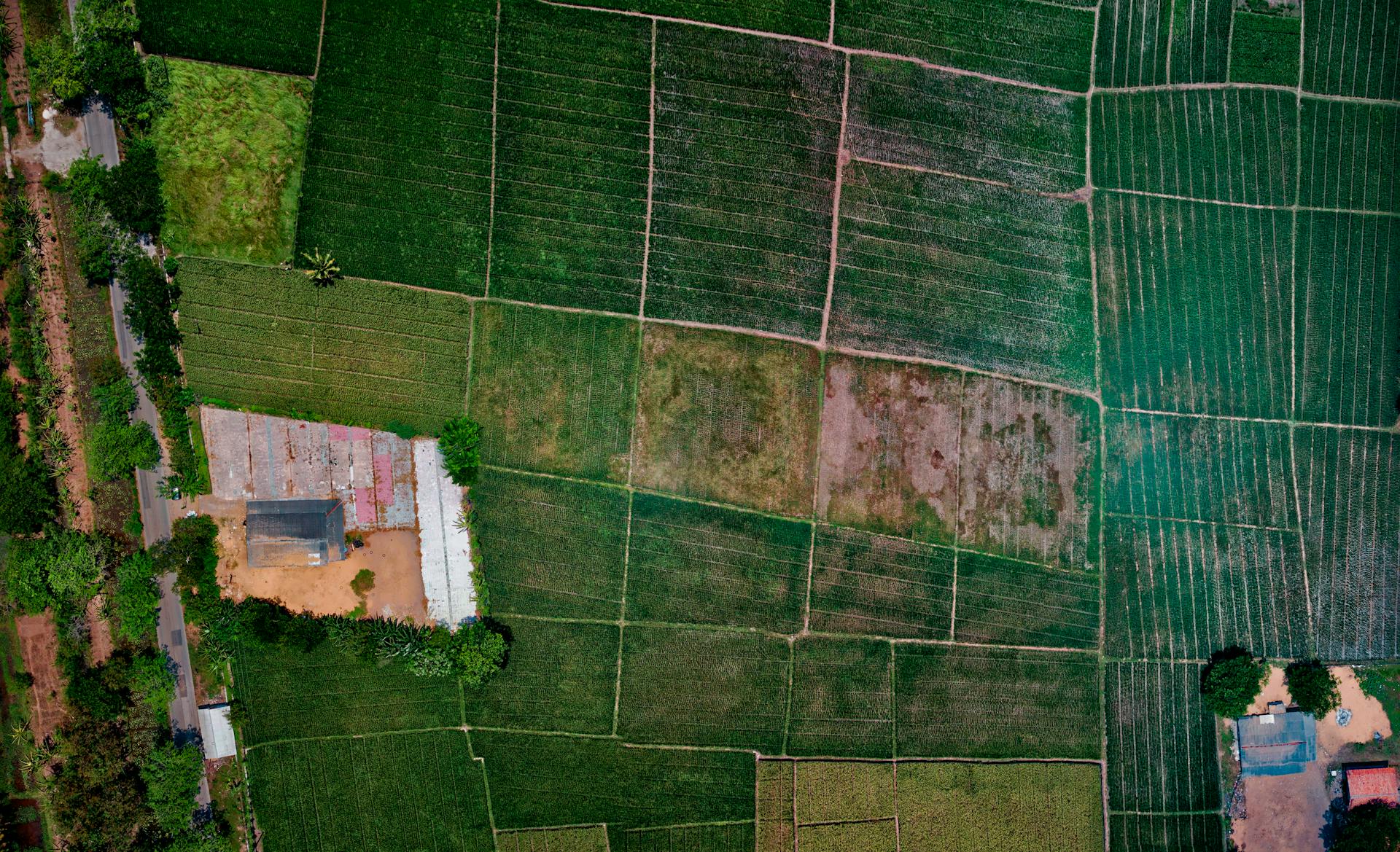
If you're new to the world of RC drone planes, don't worry - it's easier than you think to get started.
A key factor to consider when choosing your first RC drone plane is the size of the model, which can range from a few inches to several feet in length.
For beginners, a smaller drone plane is often a good starting point, as it's more stable and easier to handle.
RC drone planes can be powered by either electric motors or gasoline engines, with electric motors being a popular choice for their quiet operation and ease of maintenance.
If you're looking for a more realistic flying experience, a gasoline-powered drone plane may be the way to go, but be prepared for a higher price tag and more maintenance requirements.
Curious to learn more? Check out: Drone Hits Plane
Understanding Controls
The four main drone controls are Roll, Pitch, Yaw, and Throttle. These controls will help you master the art of flying your RC drone plane.
Roll is done by pushing the right stick to the left or right. Literally rolls the drone, which maneuvers the drone left or right.
Pitch is controlled by pushing the right stick forwards or backward. This tilts the drone, which maneuvers the drone forwards or backward.
The left stick controls Yaw. Pushing it to the left or right rotates the drone left or right. This helps with changing directions while flying.
Throttle is controlled by pushing the left stick forwards to increase altitude, or pulling it backward to decrease altitude.
Here's a summary of the four main drone controls:
These controls are intuitive when facing the drone with the camera pointed away from you.
Pre-Flight Checks
Before you take to the skies with your rc drone plane, it's essential to go through a thorough pre-flight check. This will ensure you and your drone are safe and ready for flight.
First, conduct an Airspace Research check to review airspace classifications, check for NOTAMs and TFRs, and secure any necessary authorization. You can use LAANC for instant approval or get approval via the FAA DroneZone in advance if LAANC isn't available.
A Visual Aircraft & System Inspection is also crucial. Look for any abnormalities in the aircraft frame, propellers, motors, and undercarriage. Also, inspect the gimbal, camera, transmitter, payloads, and make sure everything is clean and in good working order.
Here are some key pre-flight checks to keep in mind:
Checklist
Before you take to the skies, it's essential to go through a thorough pre-flight checklist to ensure you and your drone are safe. This checklist can be broken down into several key areas.
Start by checking the weather and site safety. A quick review of the weather forecast and an assessment of the site conditions can help you avoid any potential hazards.
You should also conduct an airspace classification review to ensure you're flying in a safe and authorized area. This involves checking for any temporary flight restrictions (TFRs) or notices to airmen (NOTAMs).
Make sure your drone's batteries are fully charged and up to date, and that all necessary software updates have been installed. You should also check your drone's connectivity to ensure it's functioning properly.
A visual inspection of your drone and its systems is also crucial. This includes checking for any damage or wear and tear.
Once you've completed these checks, it's time to power up your drone and prepare for takeoff. This final check will ensure everything is in working order before you lift off.
Visual Inspection
A visual inspection is a crucial part of your pre-flight checks. It's essential to ensure your drone is in good condition before taking off.
Start by checking that your registration number is displayed properly and is legible. This is a simple step that can save you a lot of trouble in the long run.
Next, look for any abnormalities on your aircraft frame, propellers, motors, and undercarriage. I've seen many pilots overlook these details, only to have their drone malfunction mid-flight.
Inspect your gimbal, camera, transmitter, payloads, and other components for any signs of damage or wear. This includes checking the gimbal clamp and lens caps – make sure they're removed before flying.
Clean your lens with a microfiber cloth to ensure optimal image quality. A dirty lens can ruin your photos and videos.
Before taking off, attach your propellers, battery/fuel source, and insert your SD card or lens filters. This will get your drone ready for flight.
Explore further: Drone Taking down Helicopter in Ukraine
Flight Basics
Learning to fly an rc drone plane can be a bit overwhelming at first, but don't worry, we've got you covered. To get started, you need to practice, a lot. The more you practice, the more comfortable you'll become with the controls.
The first thing to know is that the left stick controls yaw and throttle, and the right stick controls roll and pitch. Some transmitters allow you to switch these controls based on what's most comfortable.
Start by pushing the sticks very gently so the drone performs slight movements. As you get more comfortable, you can make sharper movements. Don't worry if it seems complicated at first, it's not as hard as it seems.
Here are the basic steps for flying left/right and forward/back:
To get your drone airborne, follow these steps: Take-off to eye-level altitude for about 10-15 seconds, look for any imbalances or irregularities, listen for abnormal sounds, pitch, roll, and yaw to test control response and sensitivity, check for electromagnetic interference or other software warnings, and do one final check to secure safety of flight operations area.
Advanced Techniques
Mastering advanced techniques is key to taking your rc drone plane flying to the next level.
Fly in a "figure 8" pattern by keeping the front-facing forward the entire time.
This requires some practice, but it's a great way to improve your control and precision.
Bank turns are another essential skill to master.
Bank turns involve making consistent circular turns in either the clockwise or counterclockwise direction.
To perform a bank turn, apply throttle and roll the drone in the direction of the turn (left or right) while keeping a little forward pitch for forward movement.
To get started with bank turns, try practicing in a safe and open area.
Remember to keep your drone at a safe height and distance from obstacles.
With practice, you'll be able to execute smooth and precise bank turns in no time.
Advanced Techniques + NIST Bucket Stand Practice
Mastering advanced drone flying techniques takes time and practice, but with the right skills, you'll be navigating the skies in no time.
To start, try flying in a "figure 8" pattern. This will require you to fly the drone with the front-facing forwards the entire time.
Bank turns are another essential technique to master. A consistent circular turn in either the clockwise or counterclockwise direction is key. To execute a bank turn, keep a little forward pitch for forward movement. Apply throttle, and roll the drone in the direction of the turn (left or right).
Practice these techniques on a NIST bucket stand to get a feel for the drone's movement and control.
Ornithopters
Ornithopters are a type of RC model that take inspiration from nature.
These models are often made to look like real birds and can actually fly by flapping their wings. It's not uncommon for spectators to be surprised by their ability to fly. Some ARF (almost-ready-to-fly) ornithopters are available, making it easier for hobbyists to get started.
PLA and ABS are commonly used materials to print ornithopter models using 3D printers.
Equipment and Settings
You'll need a few basic ingredients to get started with an FPV setup, including a camera and video transmitter, a method of viewing the video feed like goggles or a monitor, and a recording device if you want to capture your flights.
To ensure compatibility, it's a good idea to buy everything as a package, such as the FatShark Attitude set, or carefully choose each item to make sure they work together.
A safe option is to buy everything as a package, such as the aforementioned FatShark Attitude set, as this ensures compatibility of all items.
The type of antenna you choose can also impact your setup - circular antennas perform better due to the way the signal is transmitted and received.
Here's a quick rundown of the basic equipment you'll need:
- Camera and video transmitter
- Method of viewing the video feed (goggles or monitor)
- Recording device (optional)
Bind-N-
Bind-N-Fly (BNF) aircraft are similar to Ready to fly aircraft, except they do not come with a transmitter.
You'll need to bind them to one instead, making them a great option for flyers who already own a transmitter. This way, you can avoid dealing with transmitter incompatibilities.
Some BNF models work with transmitters using the DSM2/DSMX standard, while others use the Tactic/AnyLink standard.
A programmable transmitter is desirable for storing custom parameters for multiple models, so you don't have to alter trim and other advanced functions when switching models.
To bind your BNF aircraft, you'll need to follow the manufacturer's instructions, which are usually found in the user manual.
Here's a quick rundown of the different types of BNF models:
It's worth noting that some BNF models are more complex than others, so be sure to research the specific model you're interested in to ensure it's a good fit for your needs.
On-Screen Display
An on-screen display, or OSD, can provide a more comprehensive viewing experience for FPV flying.
It connects between the camera and video transmitter, delivering flight information to your monitor or goggles.
This information can include trip distance, distance from home, speed, altitude, climb and descent rates, and even an arrow to show you the way home if you get lost.
Additional reading: Security Drones for Home
If you opt for an OSD without GPS, the information will be much more limited.
The Cyclops Storm is an example of a well-functioning OSD unit that provides useful flight information.
The Return To Home, or RTH, feature is a very beneficial feature of good OSD units for FPV flying.
It allows the aircraft to return to its launch point, or very close to it, once the feature is activated by the pilot.
The OSD unit stores the launch point co-ordinates acquired when the unit is initialised, and takes directional control of the model to fly it back to those co-ordinates.
A safety height can be programmed in so that the aircraft will circle at that height until RTH is deactivated and the pilot can land manually.
It's common practice to program the RTH to kick in as a Tx failsafe feature, so if the radio signal from transmitter to aircraft is lost, the aircraft will return home instead of flying off.
Check this out: Remote Drone Pilot
Channels and Frequency Control

You need to choose the right frequency for your FPV flying, and there are four options: 900MHz, 1.2GHz, 2.4GHz, and 5.8GHz. Each has its pros and cons, so it's essential to research and decide which is best for your situation.
Before you start flying, make sure your transmitter and receiver are on the same frequency. Traditionally, this was referred to as a frequency channel, but modern computer receivers have made this term less common.
A four-channel RC system gives you basic flight controls, including elevator, rudder, throttle, and ailerons. This setup allows you to control pitch, yaw, engine rpm, and roll.
Here's a quick rundown of the basic flight controls:
- Elevator (or horizontal stabilizer) – controls pitch (up and down).
- Rudder (or vertical stabilizer) – controls yaw (left and right).
- Throttle – controls engine rpm (or thrust for jets and ducted fans, or motor speed for electric RC Aircraft).
- Ailerons – control roll.
Remember, your transmitter and receiver must be on the same frequency for your aircraft to be controlled in flight.
Airframe Materials
Wood is a popular choice for model radio-controlled aircraft airframes due to its low cost, high stiffness, and good workability.
Lightweight strong varieties like balsa wood are preferred for their excellent strength-to-weight ratio.
Carbon fiber is used to reinforce the structure of more recent models, and it replaces wood entirely in high-performance models like turbine engine powered aircraft and helicopters.
However, carbon fiber is quite expensive.
Expanded polystyrene and extruded polystyrene foam (Styrofoam) are used for the construction of the entire airframe, offering a more affordable option.
Foam airframes are often referred to as "Foamies" and are commonly used in basic trainers that can withstand rough handling.
Twinwall extruded polypropylene sheet, also known as Correx, is another material used for airframes, offering exceptional toughness and light weight.
However, it requires specific two-part contact glues and can be difficult to paint due to low surface adhesion.
A unique perspective: How Are Drones Used for Agricultural Purposes
Regulations and Safety
Before you start flying your rc drone plane, it's essential to check the weather and site safety. You should ensure there's a chance of precipitation less than 10%, wind speed under 15 knots, and visibility of at least 3 statute miles.
To avoid any accidents, it's crucial to take out the battery of the drone before doing any work on it. If it turns on accidentally and the propellers start spinning, you might have a tough time doing future flights with missing fingers.
When choosing a safe and legal flight location, start in a large, open space, such as a park or a field, and stay away from people or animals. Avoid windy conditions as a beginner and be aware of your drone's performance limitations.
Here are some key things to check before flying:
- Chance of precipitation less than 10%
- Wind speed under 15 knots
- Cloud base at least 500 feet
- Visibility at least 3 statute miles
- Establish take-off, landing, and emergency hover zones
- Look for towers, wires, buildings, trees, or other obstructions
- Look for pedestrians and/or animals and set up safety perimeter if needed
Regulations on rc drone plane use vary by country, so it's essential to check the laws in your area. In the UK, for example, the CAA and BMFA have specific rules for FPV flying, which can be found on their website.
Important Note
As you start flying your drone, it's essential to understand the control layout to avoid accidents and ensure a smooth experience.
Pushing the right stick to the 'right' rolls the drone right, while pushing it to the 'left' rolls it to the left. This is a fundamental aspect of drone control.
When the drone's camera is facing you, however, the controls are inverted. This means the drone will move in the opposite direction based on the stick input.
To avoid confusion, pay close attention to the way the drone is oriented towards you when you start providing stick input. This will help you navigate the drone safely and efficiently.
Site Safety Check
When flying a drone, it's essential to conduct a thorough site safety check before taking off. This involves checking the weather and site conditions to ensure a safe flight.
The chance of precipitation should be less than 10% to avoid any potential issues. This is crucial to prevent damage to the drone or its surroundings.
Establishing take-off, landing, and emergency hover zones is also vital. These zones should be clear of any obstacles or hazards.
You should also be aware of potential electromagnetic interference and look for towers, wires, buildings, trees, or other obstructions in the area. This will help you plan a safe flight path.
Visibility is another critical factor, and it should be at least 3 statute miles (SM). This will ensure you can see and avoid any obstacles or other aircraft.
Here's a quick checklist to help you perform a site safety check:
- Chance of precipitation less than 10%
- Wind speed under 15 knots (less than 20 mph)
- Cloud base at least 500 feet
- Visibility at least 3 statute miles (SM)
- Potential for electromagnetic interference?
- Look for towers, wires, buildings, trees, or other obstructions
Remember to discuss your flight mission with other crew members if present, and set up a safety perimeter if you spot pedestrians or animals in the area.
Learning Safety Tips
First and foremost, remember that drones aren't toys and can be dangerous. Keep your fingers away from the propellers when they're moving.
If you're about to crash into something, turn the throttle down to zero, so you don't potentially destroy your drone, injure somebody, or injure yourself. This is crucial to prevent damage to your drone and potential harm to people or animals.
Take out the battery of the drone before doing any work on it. If it turns on accidentally and the propellers start spinning, you might have a tough time doing future flights with missing fingers.
To ensure a safe flight, start by taking out the battery and then follow these essential tips:
- Keep your fingers away from the propellers when they're moving.
- Turn the throttle down to zero if you're about to crash into something.
- Take out the battery before doing any work on the drone.
When learning to fly indoors, tie the drone down or surround it with a cage to prevent any potential damage or injury.
Regulations on Use
Regulations on use are not just a suggestion, but a requirement in many countries. Various countries have regulations and restrictions on model aircraft operations, even for non-commercial purposes, typically imposed by the national civil aviation authority.
It's essential to check the specific regulations in your country before flying. The rules and regulations can differ from country to country, so it's crucial to investigate your country's laws for radio control flying in general.
In the UK, for example, the CAA and BMFA have laid down specific rules for FPV flying, which can be found on their website. Similarly, in the United States, the AMA website provides information on model flying regulations.
Ignoring the regulations can have serious consequences, including prosecution. People have been successfully prosecuted for illegal flying of model aircraft, even if it was unintentional.
Frequently Asked Questions
Which is better, RC plane or drone?
Quadcopters, also known as drones, are generally easier to fly due to their stable four-rotor design. If you're a beginner, a drone might be the better choice for a fun and hassle-free flying experience.
How fast can RC drones fly?
RC drones can fly at speeds ranging from 45 mph for consumer models to over 100 mph for racing drones, with some reaching incredible velocities of up to 360 mph. Their speed capabilities vary greatly depending on their intended use and design.
Featured Images: pexels.com


